Paul Dobraszczyk and Peter Sealy
Routledge

Function and Fantasy: Iron Architecture in the Long Nineteenth Century, edited by Paul Dobraszczyk and Peter Sealy, revisits the history of a quintessentially nineteenth-century industrial building material. The collection of eleven essays focuses on iron architecture in the second half of the century, especially in Britain and its colonies. Scholarly assessments of metal architecture in this period traditionally stress steel’s gradual replacement of iron, rendering iron as a provisional phase in the technological evolution of industrial construction materials. The book’s strength rests in the editors’ decision to reject the technological determinism of this prevailing narrative. Instead, the book reorients iron around the aesthetics of its lavish decorative uses as both structure and ornament, as evoked in the title’s alliteration. The book’s emphasis on aesthetics, however, is not merely an investigation into form-making. The volume’s contributors animate iron’s shifting aesthetic implications through cultural history, probing iron’s relation to architectural representation in the age of nineteenth-century historicism.
In addressing the aesthetics of iron, Function and Fantasy expands the history of nineteenth-century architecture beyond theories of structural rationalism. Dobraszczyk and Sealy distinguish their enterprise from the technocentric focus of early historians of modernist architecture, such as those by Peter Collins, Sigfried Giedion, Henry-Russell Hitchcock, and Nikolaus Pevsner. As Dobraszczyk and Sealy recount, in Space, Time, and Architecture (1941), Giedion interpreted nineteenth-century metal construction as a precursor of the aesthetic and structural revolution of early twentieth-century modernist architecture. Although the editors rightly reject Giedion’s reductive story, their use of his account as a historiographic foil oversimplifies the more complex assessments of metal architecture that have been penned in the eighty years since the publication of Giedion’s grand récit.1 This wider body of literature is cited throughout the book, but the editors do not adequately frame the publication in terms of it.
The book’s essays are divided into three thematic sections that progress in a rough chronology. The first part of the book establishes a foundation for reassessing iron architecture on aesthetic terms by addressing canonical examples of iron architecture and the theoretical underpinning of the material’s applications in Britain, France, and German-speaking Europe. John Stamper, eminent historian of metal architecture, reevaluates Joseph Paxton’s Crystal Palace at the 1851 Great Exhibition in London’s Hyde Park. Enhancing the building’s traditional understanding as a watershed moment in the technical capacities of iron construction, Stamper tracks the changing historical reception of the building’s aesthetics in relation to its polychrome iron frame and the spatial qualities of the airy interior. Nathaniel Robert Walker considers another canonical Victorian iron structure, Benjamin Woodward’s 1860 court in the neomedieval Oxford University Museum. Walker situates the iron-and-glass structure within contemporary intellectual exchanges between architecture and the natural sciences, drawing a visual analogy (what he calls “paleostructure”) between the skeletonized iron frame and the bones showcased inside. The next two essays turn to the challenges that iron posed to aesthetic conventions in the early and mid-1800s. Axel Sowa examines how the mass production of cast iron—especially in Prussian foundries—helped popularize neoclassicism, effectively dethroning the aesthetic tradition from elite spheres of cultural production. Lastly, Jasper Cepl turns to intellectual history to assess the little-studied architectural theory of Prussian architect Richard Lucae. Cepl sheds light on Lucae’s spatial conception of iron architecture in two lectures of the late 1860s.
Despite its nominal aesthetic focus, the book’s middle section, “Exchanges,” emphasizes Britain’s exportation of iron to its formal and informal colonies, constituting the volume’s most original contribution. Anne Warr probes Britain’s exportation of iron and draws private industry into the story of nineteenth-century empire building. Warr contends that “corrugated iron tells a story about the relationship between Britain and Australia—or, between colonizer and colonized” (181). Jonathan Clarke deftly assesses prefabricated cast- and wrought-iron buildings that the British exported to West Africa, Latin America, the Middle East, and South Asia at midcentury. Lucia Jaurez investigates Argentina’s substantial use of Scottish cast iron (in buildings, railroads, and other public works campaigns), drawing on European technology and cultural capital to shape Argentine modernity. And Elizabeth Pigou-Dennis interrogates similar building types in colonial Jamaica. These essays will be welcomed by those of us who teach nineteenth-century architectural history and seek to demonstrate how imperialism and capitalism inextricably tied architecture to global modernity.
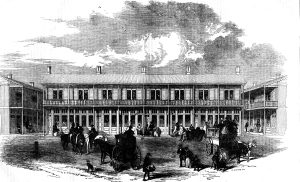
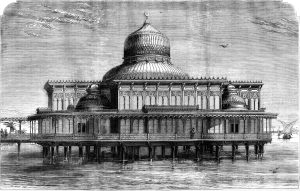
The conceptually ambitious essays in the book’s final section, “Transformations,” position the aesthetics of iron architecture in relation to theories of modernity. Dobraszczyk’s essay, based on a chapter of his 2014 monograph, interprets the novel spatial aesthetics of iron railroad sheds through Siegfried Kracauer’s conception of ornament.2 For Kracauer, ornament contained the capacity to draw people into architectural experience in light of the fragmentation and alienation of daily life. From a complimentary perspective, Sealy analyzes Émile Zola’s literary depictions of Parisian roofscapes through Walter Benjamin’s dialectical concept of the “wish image,” which negotiates resolutely contemporary forms with a mythic past.3 For example, Sealy likens Zola’s descriptions of the iron roofs of Victor Baltard’s iron-and-glass Les Halles, of 1853–70, to “vast oceans” that conjure a mythic natural world in the urban environment and thus show the volatile reception of iron’s modernity. Insofar as Dobraszczyk’s and Sealy’s essays interpret the modernity of iron architecture through critical theory, Charles Rosenblum’s final essay does so historiographically. Rosenblum turns to the designs of engineer Gustav Lindenthal and architect Henry Hornbostel for the Williamsburg, Manhattan, and Queensboro bridges built across New York City’s East River in the first decade of the twentieth century. Rejecting the assumption that the aesthetics of modern bridges uniquely rest in their structural expression, Rosenblum instead discloses the historical importance of their cast-iron ornament. His essay thus concludes the book by returning to Dobraszczyk and Sealy’s introductory challenge to the early historiography of modernist architecture.
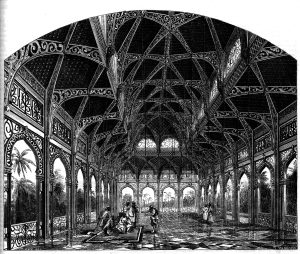
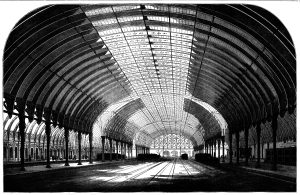
Function and Fantasy revisits nineteenth-century iron architecture by analyzing the building material’s aesthetics as part of the cultural experiences of modernity. The book’s aesthetic focus invites an investigation into the other histories of nineteenth-century metal architecture that also warrant attention. Perhaps most urgent is a radical rereading of iron architecture in light of its materiality. Such an assessment might study the use of iron ore on a global scale, looking to French North Africa, which was a major source of European iron ore in the second half of the nineteenth century. Such a study would chart the labor—forced and otherwise—invested in harvesting, transporting, and transforming the resource into a building material. Following Adrian Forty’s Concrete and Culture, such an inquiry might also consider the environmental implications of iron’s lifecycle in light of the ecological crises triggered by industrialization more broadly.4 These are pressing issues, for they help historicize architecture’s often exploitative relationship to resources and labor. The ability to sketch out these lines of inquiry depends on the kinds of cultural analyses in Function and Fantasy’s well-researched and lucid essays; although the essays address predominant architectural questions about aesthetics, they place these questions in the ambit of a broader cultural field.
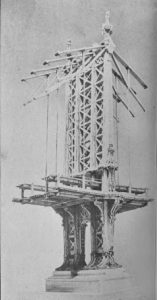
Endnotes:
- See, e.g., Kenneth Frampton, Studies in Tectonic Culture: The Poetics of Construction in Nineteenth and Twentieth Century Architecture (Cambridge, MA: MIT Press, 1995); Cecil Elliott, Technics and Architecture: The Development of Materials and Systems for Building (Cambridge, MA: MIT Press, 1994); Tom F. Peters, Building the Nineteenth Century (Cambridge, MA: MIT Press, 1996); Andrew Saint, Architect and Engineer: A Study in Sibling Rivalry (New Haven, CT: Yale University Press, 2008); R. J. M. Sutherland, ed., Structural Iron, 1750–1850 (Aldershot: Ashgate, 1997); and Robert Thorne, Structural Iron and Steel, 1850–1900 (Aldershot: Ashgate, 2000).
- See Paul Dobraszczyk, Iron, Ornament, and Architecture in Victorian Britain: Myth and Modernity, Excess and Enchantment (Farnham: Ashgate, 2014).
- Sealy’s essay should be read alongside Anthony Vidler’s interpretation of architecture in Zola’s novels in his classic 1971 essay, “The New Industrial World: The Reconstruction of Urban Utopia in Late Nineteenth Century France,” Perspecta 13/14 (1971): 243–56.
- See Adrian Forty, Concrete and Culture: A Material History (London: Reaktion Books, 2012), 69–77.
Sean Weiss is Assistant Professor of Architectural History at the Spitzer School of Architecture at the City College of New York. His essays and reviews have appeared in Casabella, Journal of Urban History, Journal of the Society of Architectural Historians, Log, and the edited volume Non-Standard Architectural Productions: Between Aesthetic Experience and Social Action (Routledge, 2019). He is writing a book about the photographic practices of civil engineers in the construction and maintenance of urban infrastructure in modern Paris.
How to Cite This: Weiss, Sean. Review of Function and Fantasy: Iron Architecture in the Long Nineteenth Century, by Paul Dobraszczyk and Peter Sealy. JAE Online. February 21, 2020. http://www.jaeonline.org/articles/review/function-and-fantasy#/.






